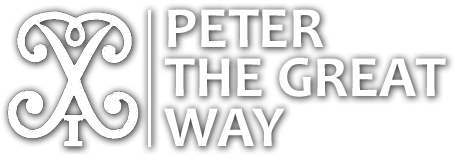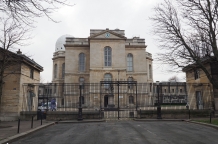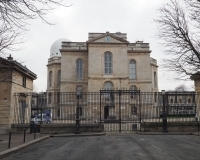Paris Observatory (Observatoire de Paris)
“And for astronomy, there is an observatoire – or an elevated site for observing stars – in the suburb Saint Jacob, outside the city limits”, wrote Andrey Matveev, a diplomat under Peter I. The construction of the Paris Observatory for astronomers of the Royal Academy of Sciences was initiated by Jean-Baptiste Colbert and started by Louis XIV in 1667. The building was built to the design of famous architect Claude Perrault in the outskirts of Saint-Jacques in 1672. It was a real palace of science. Its spacious basements were intended for conducting physical and mathematical experiments and the upper floor was used for astronomical observations. The building design did not use metal parts in order not to disturb magnetic experiments. The four facades of the building are strictly aligned to the cardinal points and the central axis of the building was designed to coincide with the Paris meridian.
The surviving building of the Observatory is a masterpiece of French Baroque architecture of the 17th century. The southern facade of the square plan building is flanked by two octagonal towers which are as tall as the main building. The third square plan tower bulges out in the middle of the northern wall of the building. Topped with a simple triangular gable, the tower determines the appearance of the northern façade of the building which currently faces the Avenue de l’Observatoire. Horizontal corbel courses divide the smooth walls into two levels, with the second floor being well above the first floor and the Venetian windows being correspondingly larger. The roof of the building is decorated with a stone balustrade. Low side wings and domes were added in the 19th century.
The Paris Observatory attracted keen interest of Peter I. More details about the Tsar’s visits to the Observatory on May 1/12 and 8/19 and on June 6/17, 1717 have survived in French sources. The most thorough reports are found in the newspaper Nouveau Mercure: “On the 12th [of May]… he came to the Observatory after lunch. He stayed there for a very short period of time and promised to come back in order to see everything”; “on the 19th [of May] after lunch, the Monarch visited the Observatory again and Mr. Maraldi showed him everything used for astronomical observations. This time, the Tsar showed his education and knowledge acquired in this science”; “on the 17th [of June]… he visited the Observatory yet one more time and stayed there for about two hours to make [astronomical] observations”. In 1717, the Observatory was headed by Jacques Cassini. While using the telescopes, the Tsar was accompanied by his nephew Jacques Philippe Maraldi, a famous astronomer and mathematician. Driven by his interest in astronomy, the Tsar bought a moving model of celestial sphere from the Paris’ famous artisan Jean Pigeon.
The Paris Observatory continues to be the world’s center of astronomical research. Currently, it houses the International Time Bureau.



